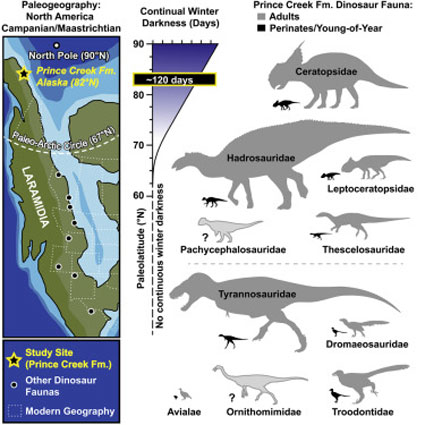Analysis of sediments taken from the famous Prince Creek Formation of northern Alaska has revealed tiny, fossilised bones and teeth representing perinatal dinosaurs – either embryonic (just about to hatch) or dinosaurs that have recently hatched. Several different types of dinosaurs are represented, which means that high latitudes in the Northern Hemisphere were probably the dinosaur’s permanent home and that they nested there.

A Dinosaur Nursery
Researchers from the University of Alaska Museum, the Royal Tyrrell Museum, Florida State University and the University of Colorado writing in the academic journal “Current Biology”, report the discovery of tiny teeth — some less than 2 mm in length along with bones from seven species of perinatal dinosaurs. These tiny fossils were found after conducting a microscopic analysis of sediments from the bluffs that can be found along the shores of the Coleville River. These sediments are from the Prince Creek Formation and represent deposition that took place around 70 million years ago,
The field season is very short at such a high latitude. In the three weeks of field work that are possible, the team removed hundreds of kilograms of sediment from the face of the bluffs. The buckets of sediment are hauled down to the river’s edge, where team members wash the material through smaller and smaller screens until they have removed any large rocks and soil.

Once back at the lab, researchers run the material through more screens to remove all the clay, until all that’s left is sandy particles. Then, teaspoon by teaspoon, the team, including graduate and undergraduate students examine the sand under microscopes to find the tiny bones and teeth. This work has revealed tiny teeth of mammals, but in addition, tiny teeth and bones of dinosaurs have been discovered.

Endothermic Dinosaurs
Although not as cold as today, conditions in this part of northern Laramidia during the Late Cretaceous were extremely challenging. For around 120 days each year there was total darkness and it has been calculated that the mean average temperature was just 6.3°C ± 2.2°C (43.3°F ± 4.0°F). The Eumeralla and Wonthaggi Formations of Australia at a palaeolatitude of about 70° south, have also provided evidence of recently hatched dinosaurs and yearlings.
However, the Prince Creek Formation at a latitude of 80°– 85° north represents the most extreme environment yet described for the Dinosauria. Intriguingly, whilst dinosaurs living in southern Gondwana (Eumeralla and Wonthaggi Formation fossil remains), would have experienced around 45 days of total darkness each year, this palaeoenvironment was still warm enough for ectothermic animals such as crocodilians and amphibians to thrive. However, no such “cold-blooded” animals are found in association with Prince Creek Formation sediments.
To survive such harsh conditions, the researchers conclude that the dinosaurs of Prince Creek Formation were endothermic, just like modern mammals and birds.

Lead author of the research Patrick Druckenmiller (University of Alaska Museum) commented:
“Recovering these tiny fossils is like panning for gold. It requires a great amount of time and effort to sort through tonnes of sediment grain-by-grain under a microscope. The fossils we found are rare but are scientifically rich in information”.
Dinosaurs were Year-round Residents of Northern Alaska
The presence of such young dinosaurs, who were not capable of making long, seasonal migrations is strong evidence to suggest that the dinosaur biota was present all year. The palaeoenvironment was extreme but numerous different types of dinosaur were able to thrive in this harsh habitat.

This discovery demonstrates just how adaptable members of the Dinosauria were and hints at a diverse and rich dinosaur dominated ecosystem hundreds of miles inside the Palaeo-Arctic Circle.
The scientific paper: “Nesting at extreme polar latitudes by non-avian dinosaurs” by Patrick S. Druckenmiller, Gregory M. Erickson, Donald Brinkman, Caleb M. Brown and Jaelyn J. Eberle published in Current Biology.
Visit the Everything Dinosaur website: Everything Dinosaur.






Leave A Comment